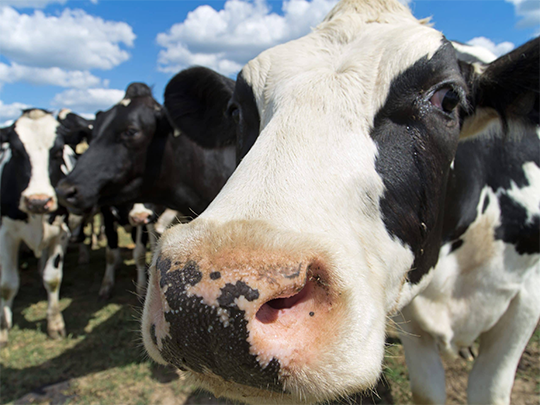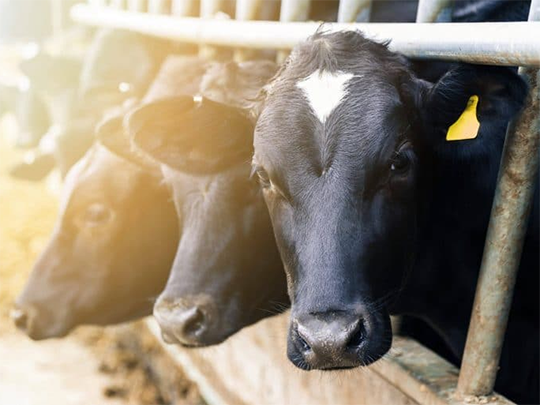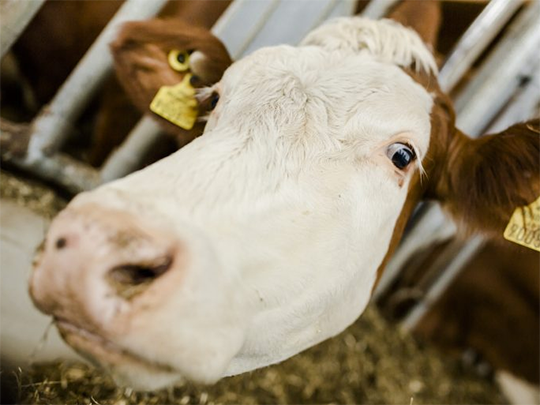Reducing methane emissions from cattle (part 1)
It's getting hotter and hotter. Climate Change not only affects us but especially our livestock. But what role plays methane here? Find out in part 1 how ruminants contribute to methane emissions...
It’s getting hotter and hotter – not only the temperature on earth, but also the mood in the population. Climate change is becoming increasingly apparent. The worldwide “Fridays for Future” movement is heating up the discussion in politics about new climate protection measures. What measures can these be? What possibilities does nature offer to reduce the emission of one of the most dangerous greenhouse gases by ruminants – methane? So what about reducing methane emissions from cattle?
After reading this first part of this article you will know...
- the Impact of methane on climate change
- why ruminants produce methane
- how methane is produced from carbohydrates

Global warming due to the increase in atmospheric gases such as CH4 and CO2 is an important issue.
The greenhouse effect, i.e. the influence of greenhouse gases in the Earth’s atmosphere on the Earth’s heat balance, is becoming increasingly apparent. Climate researchers predict that by 2030 the world will be 1-2°C warmer than it is today. Not only the “Fridays for Future” movement, but also the Intergovernmental Panel of Climate Change (IPCC) therefore calls on the industrialised countries to assess the quantities of greenhouse gases produced in their respective countries and to focus research and development on techniques to reduce these emissions within a certain period of time (Moss et al., 2000).
Did you know?
When it comes to climate change, everyone talks about carbon dioxide (CO2). It is considered the main driver of global warming. But methane in particular should not be underestimated as a greenhouse gas: Its effect is 21 times stronger than carbon dioxide (FAO, 2013).
| Gas | Duration (years) | Capacity to absorb radiation | GHG emissions contributions |
| CO₂ | 125 | 1 (reference) | 48 % |
| CH₄ | 12 | 21 | 17 % |
| N₂O | 150 | 310 | 6 % |
Anthropogenic greenhouse gas emissions are associated not only with industrial activities…
…but also with animal production.
The enteric fermentation of ruminants in particular contributes 40% to the emission of greenhouse gases from agriculture (FAO, 2013). Agriculture itself contributes to about 24% of global greenhouse gas emissions (Holmberg and Erdemir, 2017).
Researchers predict that the world population will rise to around 9 billion people by 2050.
The demand for animal protein is expected to double. According to McAllister et al (2011), this rising demand will lead to an increase in total greenhouse gas emissions from the livestock sector. In addition, the increase in livestock numbers is expected to take place primarily in developing countries. Measures are needed to reduce greenhouse gas emissions despite rising livestock production. Especially reducing methane emissions from cattle.
Global greenhouse gas emissions by economic sector:
5 short facts about methane emissions from ruminants
- Between 2 and 12% of the energy for growth or milk production is lost through methane emissions, which is about 23MJ of convertible energy or the equivalent of about 4.5L of milk
- By increasing feed efficiency, methane emissions can be reduced
- Lactating cows produce about 200-600g of methane per animal per day, fattening cows about 80-220g per animal per day (Flachowsy and Brade, 2007)
- The annual methane production of a dairy cow has the same impact on global warming as a car journey between 9000 and 13000000 km, which produces carbon dioxide
- In ruminants, around 90% of methane production comes from the rumen and is released through the lungs
Why do ruminants produce methane?
In the rumen of ruminant animals, methane is mainly produced by methanogenic, i.e. methane-producing Archaea bacteria as a largely unavoidable by-product of the anaerobic fermentation of carbohydrates. The rate of methane production reaches its maximum shortly after feed intake. Methane-forming archaea can be found both in the rumen fluid and in association with Cilliae protozoa (Entodinium caudatum). The main part of CH4 is formed in the rumen (Hungate, 1966), but a further part is also formed in lower sections of the intestines with microbial colonization, such as the large intestine (Kirchgessner et al., 1991). The CH4 formed in the digestive tract is partially absorbed and excreted via the lungs.
Did you know?
Flachoswky et al. (2004) estimate, that the global ruminal volume of cattle is about 150 million m³. This means that there is an enormous microbial digestion space for CH4 formation.

But how is methane produced from carbohydrates?
Ruminants have a unique digestive system that allows them to digest fibrous plant materials better than other herbivores: With the help of specific microbially formed enzymes, they are able to break down vegetable carbohydrates and use them for energy production. After the intake, carbohydrates (such as cellulose, hemicellulose, pectins or starch) are hydrolysed into the central intermediate product pyruvate in the rumen by different microbial enzymes. Afterwards, the pyruvate is further fermented into volatile fatty acids (acetate, Butyrate and propionate) and gazes (CO2 and H2).
It is a fact that the more fibre is fed, the more cellulolytic bacteria accumulate and as a consequence, the more acetate is produced. Contrary, the more dietary concentrates (including nonstructural carbohydrates like degradable starch or sugar) are fed, the more propionate is produced by the propionic bacteria, going along with a lower pH. The methane production increases with the acetate: propionate ratio and with an increase of the pH, whereas a low pH increases the propionate production and inhibits the archaea bacteria in their fermentation process. This actually means that the more feed concentrates are used in ruminant´s diets, the more NSC (nonstructural carbohydrates) intake we have and thus, the less methane will be produced.
Did you know?
While propionate is mainly used to produce glucose and thus lactose, acetate is mainly used to produce milk fat and energy.
4H₂ + CO₂ → Ch₄ + 2H₂O
The fermentation profile changes the level of methane production: During the production of acetate and butyrate, larger amounts of hydrogen (H2) are produced, which is attached to CO2 by methanogenic archaea – and that leads in the consequence to the formation of methane.
Pyruvate + 4H → propionate (C3) + H₂O
Hydrogen is needed to form propionate from pyruvate. Thus, this hydrogen is no longer available for methane formation, so less methane is produced.

Methane production increases with the acetate/propionate ratio and the pH value.
A low pH value increases propionate production and inhibits archaebacteria. This means that a higher amount of concentrated feed in the ration results in less methane – but increases the risk of rumen acidosis.
Did you know?
A part of the loss of dietary energy in dairy cows comes from methane, which is produced in the digestive tract during fermentation. Typically dairy cows show losses of about 6 to 10% of gross energy due to methane production. In ruminants, around 90% of methane production occurs in the rumen and is expired through the lungs.
And what natural approaches are there for reducing methane emissions from cattle?

Thierry Aubert
Thierry Aubert can look back on 15 years of experience in the premix, feed and meat industry. Since the beginning of his career, Thierry is in regular exchange with the farmers to understand their challenges and needs. In 2013 he joined Delacon as Species Leader Ruminants. With his team, he is in charge of the global product development for the ruminant species and customer technical support. Since spring 2018, his task areas have been extended: At the moment, he is also responsible for the coordination of the Reginal Technical Managers worldwide. In his leisure time, he likes to go running and already participated in several marathons.










